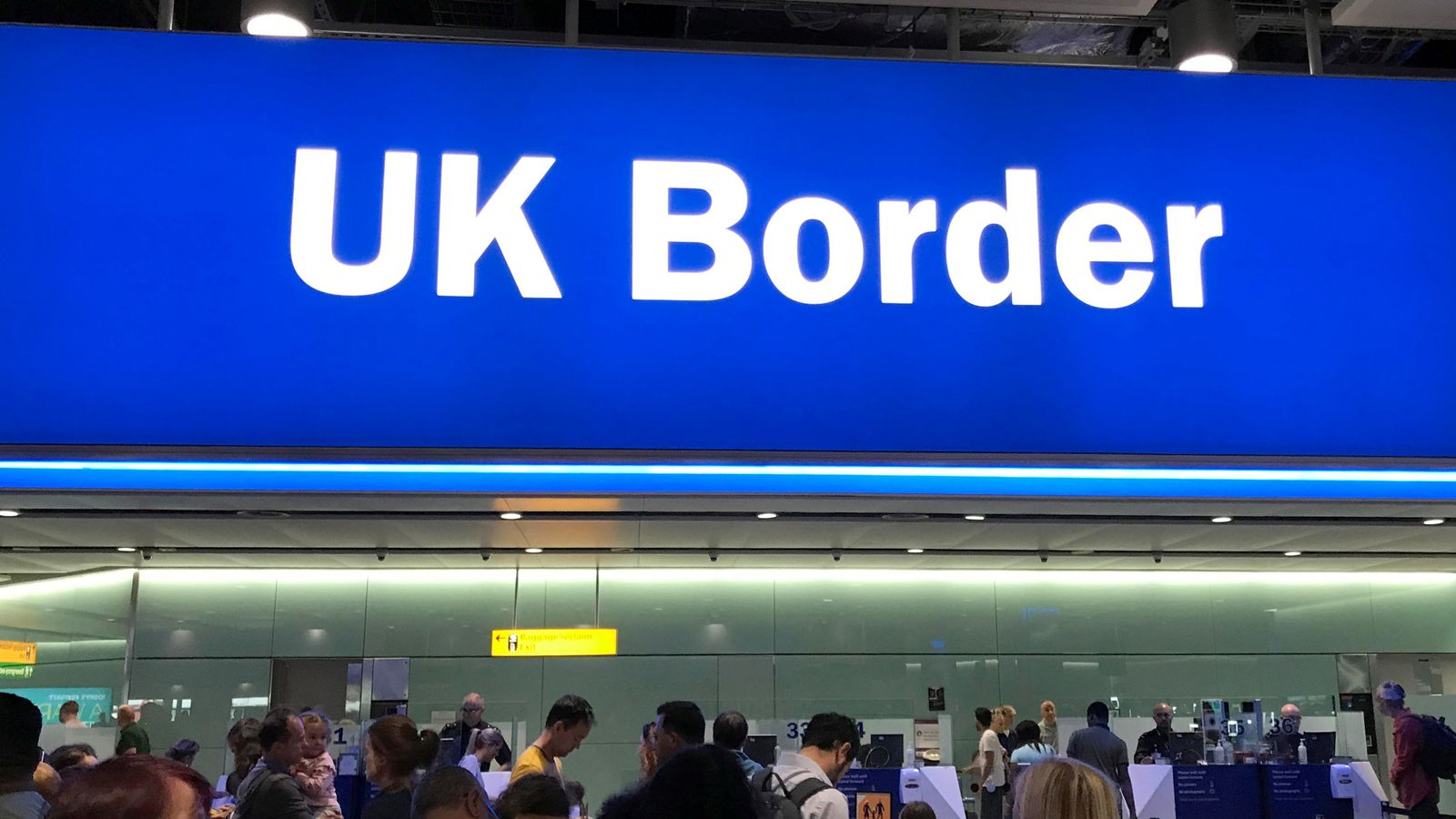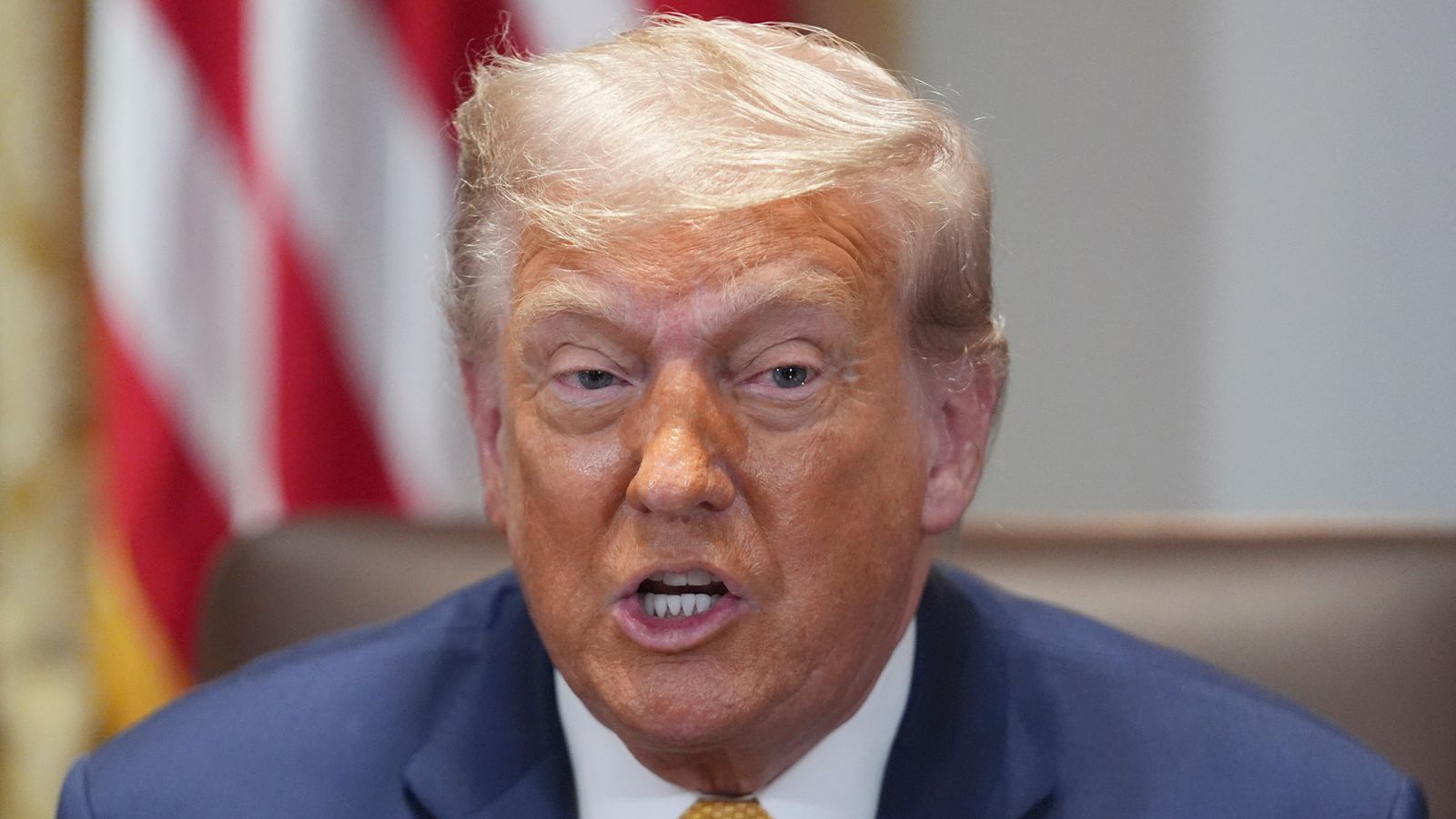
Net migration hit a record-breaking 745,000 in 2022, according to revised figures from the Office for National Statistics, as its latest numbers showed 672,000 people came to the UK in the 12 months to June 2023.
In its last figures released in May, the ONS said the number for last year was 606,000 – then deemed a record high.
But looking at the numbers again, the organisation now says the actual figure was almost 140,000 higher than first thought, making it an even more unparalleled statistic.
Politics live: Clear choice at next election, says Hunt
The latest numbers released on Wednesday showed net migration had risen when compared to the 12-month figure up to June 2022, which was 607,000, even though it was lower than the surprise annual stat for last year.
However, the ONS said while today’s number represented a drop from that unparalleled number, it was “too early to say if this is the start of a new downward trend”, even though it did indicate a slowing of immigration coupled with increasing emigration.
Net migration is calculated by looking at the number of people arriving in the UK when both immigration (people coming to the UK) and emigration (people leaving the UK) are taken into account.
From July 2019, a few months before the last general election, to June 2023, total estimated UK net migration stood at 1,611,000.
That total reflects net arrivals of 1,829,000 people from outside the EU, and net departures of 81,000 EU citizens and 137,000 British citizens.
Tory backbenchers have already begun to hit out at the numbers, with former home secretary Suella Braverman calling it “a slap in the face to the British public who have voted to control and reduce migration at every opportunity”.
She called on the government – which she was a member of until last week – to “act now”, with policies including introducing an annual cap on net migration and the number of health and social care visas given out, as well as raising the salary threshold for people to come to the country, closing the graduate visa route, and limiting the number of dependents.
Former minister Simon Clarke also called the figures “unsustainable both economically and socially”, while Tory Conservative MP, Jonathan Gullis said it was “completely unacceptable to the majority of the British people”.
It comes as Prime Minister Rishi Sunak is under increasing pressure from the right of his party to reduce net migration in light of the 2019 Tory manifesto, which promised to bring the “overall number down”.
Home Secretary James Cleverly insisted the government remained “completely committed to reducing levels of legal migration, while also “focusing relentlessly” on tackling illegal migration.
He said ministers were “working across government on further measures to prevent exploitation and manipulation of our visa system, including clamping down on those that take advantage of the flexibility of the immigration system”.
But Labour’s shadow home secretary, Yvette Cooper, said today’s statistics showed “the scale of utter Tory failure on immigration, asylum, and the economy”.
In 2010, then prime minister David Cameron – now Foreign Secretary Lord Cameron – pledged to bring net migration down to the “tens of thousands”, though successive Tory governments have sought to move away from exact targets.
According to the ONS, most people arriving in the UK in the year to June 2023 were non-EU nationals – a total of 968,000 – followed by 129,000 EU citizens and 84,000 British people.
But both EU nationals and Britons were leaving the country in greater numbers, with 10,000 more EU nationals leaving than arriving and 86,000 more British nationals leaving than arriving – while the net figure for non-EU people was 768,000 more arriving than leaving.
Work was the biggest reason people from outside the EU migrated to the UK – a net figure of 278,000 and the first time employment was the most popular reason – followed by a net figure of 263,000 coming for study.
The recent rise in work visas was mainly driven by people taking jobs in the health and care sectors.
But when it came to those studying, the ONS’s Jay Lindop said the number was rising as “we’re not only seeing more students arrive, but we can also see they’re staying for longer”.
They also said more dependants of people with work and study visas had come to the UK too.
Meanwhile, the number of people granted asylum to the UK for the year has remained relatively stable, as while it hit 88,000, compared with 73,000 in year to June 2022, ongoing COVID restrictions in that period had an impact.
The ONS said migration to the UK had been “relatively stable” before the COVID pandemic, but “patterns and behaviours have been shifting considerably since then”.
The statistics experts said net migration had “increased sharply” since 2021 due to a rise in immigration from non-EU countries – including people coming by humanitarian routes from Ukraine and Hong Kong – as well as an increase in non-EU students and workers.
Government wants to bring migration down
The government has insisted it remains committed to reducing migration, and has already introduced measures to reduce the figure, including stopping international students who come to the UK from bringing family with them except under specific circumstances.
The New Conservatives group on the Tory right has called for ministers to close temporary visa schemes for care workers and to cap the number of refugees resettling in the UK at 20,000, in a bid to reduce net migration to 226,000 by the time of the election.
In a statement released after the ONS publication, the group said: “We cannot blame exceptional circumstances. This is a consistent trend. It has been caused directly by the policy decisions of this government. And it has gone on for far too long.
“The word ‘existential’ has been used a lot in recent days, but this really is ‘do or die’ for our party. Each of us made a promise to the electorate. We don’t believe that such promises can be ignored.”
A Number 10 spokesperson said the government would “leave no stone unturned” in bringing down the figure, adding: “Net migration remains far too high. That’s why we are taking action to bring it down. That is what the British public expect.”
Last week, the Supreme Court ruled that Mr Sunak’s policy of sending asylum seekers to Rwanda – a key part of his plan to stop small boats crossing the Channel – was unlawful.
The Rwanda policy would see anyone arriving in the UK by unauthorised means, such as by Channel crossings, deported to the African country to claim asylum there and not the UK.
But in its landmark ruling last Wednesday, the Supreme Court ruled that those sent to Rwanda would be at “real risk” of being sent back to their country of origin regardless of whether their asylum claim was justified or not – something that would breach international human rights laws.
In the aftermath of the ruling, Mr Sunak doubled down on the policy, telling MPs he was prepared to “change laws and revisit… international relationships” if they were “frustrating” his plans.
However, he also acknowledged that even if domestic laws were changed, the government could still face legal challenges from the European Court of Human Rights (ECHR) and vowed: “I will not allow a foreign court to block these flights.”
The stalemate over Rwanda has bolstered calls from some in the Tory party for the UK to withdraw from the ECHR altogether after an injunction last June stopped the first scheduled flights from taking off.












